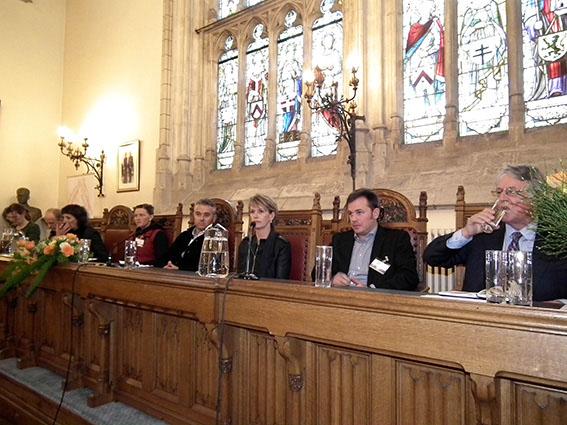Anky deelt ervaringen tijdens 7e European Equine Health & Nutrition Congress (Engels)
Gepubliceerd op 7 april 2015
Over 220 delegates from 26 countries attended the 7th edition of the European Equine Health & Nutrition Congress (EEHNC) that was hosted in Bruges (Belgium). Internationally recognized specialists in nutrition, veterinary scientists, veterinarians, industry representatives and equine professionals attended this meeting.
The congress focused on “Feeding the equine athlete”. The first day of this congress was dedicated to “Growing towards performance”. The following day was dedicated to “Feeding the Equine Athlete” (Friday). Participants could also follow practical workshops.
Professor Pat Harris (Waltham-on-the-Wolds, UK) explained how 'feeding the foal' commences with the correct nutrition of the broodmare. Nutritional factors can 'program' aspects of foal development both pre and post parturition and this is a new exciting research area within the study into environmental factors leading to activation or dormancy of certain genes. Jan Boone (Ghent University, BE) and Harold Brommer (Utrecht University, NL) highlighted how equine sports science can learn from advances and professionalization in training schedules and fitness regimes in human athletes and how this is starting to be applied at the top level of equine athletes as confirmed by scientists, Olympic team veterinarians and top riders of most equine disciplines. John McEwen (Director of Equine Sports Medicine of the British Equestrian Federation) gave great insight into how the British Olympic Equestrians are supported by top level Exercise Physiologists, Veterinarians and Nutritionist throughout their training. Nutraceuticals were explored by Pierre Lekeux (University of Liege) and Michael Lindinger (Nutraceutical Alliance), with special focus on anti-oxidants and immune supplements and how they can support health and performance in the equine athlete. Subsequently there was a focus on maintaining physiological health and avoid behavioral problems through provision of good quality and quantity of forage as the basis for the diet with added nutrients and energy supply from well formulated concentrates. In the final discussion international riders Anky van Grunsven, Karin Donckers and Lieven DeVos shared their feeding practices to provide insight in the feeding management of their horses during training, transport and international events.
The Poster Award was given to Anneleen Decloedt (Laboratory of Chemical Analysis– Ghent University). She was awarded a 500 Euro check from Peter Bollen, President of the EEHNC and Prof. Geert Janssens (Chairman EEHNC Scientific Committee) for her abstract, entitled “Does the consumption of moulded feed affect the excretion of anabolic-androgenic steroids in horses?” Her study is part of a larger study but these initial results suggest that horses should not consume moulded corn straight from the field. DeCloedt also stressed the importance of properly storing feed, label control and to offer feed produced under Good Manufacturing Practice.
The first EEHNC took place in Antwerp in 2000. The 7th EEHNC was organized in cooperation with the departments from the Faculty of Veterinary Medicine of Ghent University, Utrecht University and the University of Liège. The Animal Science Group (Wageningen University and Research Centre) was also involved.
Source: Cavalor
The congress focused on “Feeding the equine athlete”. The first day of this congress was dedicated to “Growing towards performance”. The following day was dedicated to “Feeding the Equine Athlete” (Friday). Participants could also follow practical workshops.
Professor Pat Harris (Waltham-on-the-Wolds, UK) explained how 'feeding the foal' commences with the correct nutrition of the broodmare. Nutritional factors can 'program' aspects of foal development both pre and post parturition and this is a new exciting research area within the study into environmental factors leading to activation or dormancy of certain genes. Jan Boone (Ghent University, BE) and Harold Brommer (Utrecht University, NL) highlighted how equine sports science can learn from advances and professionalization in training schedules and fitness regimes in human athletes and how this is starting to be applied at the top level of equine athletes as confirmed by scientists, Olympic team veterinarians and top riders of most equine disciplines. John McEwen (Director of Equine Sports Medicine of the British Equestrian Federation) gave great insight into how the British Olympic Equestrians are supported by top level Exercise Physiologists, Veterinarians and Nutritionist throughout their training. Nutraceuticals were explored by Pierre Lekeux (University of Liege) and Michael Lindinger (Nutraceutical Alliance), with special focus on anti-oxidants and immune supplements and how they can support health and performance in the equine athlete. Subsequently there was a focus on maintaining physiological health and avoid behavioral problems through provision of good quality and quantity of forage as the basis for the diet with added nutrients and energy supply from well formulated concentrates. In the final discussion international riders Anky van Grunsven, Karin Donckers and Lieven DeVos shared their feeding practices to provide insight in the feeding management of their horses during training, transport and international events.
The Poster Award was given to Anneleen Decloedt (Laboratory of Chemical Analysis– Ghent University). She was awarded a 500 Euro check from Peter Bollen, President of the EEHNC and Prof. Geert Janssens (Chairman EEHNC Scientific Committee) for her abstract, entitled “Does the consumption of moulded feed affect the excretion of anabolic-androgenic steroids in horses?” Her study is part of a larger study but these initial results suggest that horses should not consume moulded corn straight from the field. DeCloedt also stressed the importance of properly storing feed, label control and to offer feed produced under Good Manufacturing Practice.
The first EEHNC took place in Antwerp in 2000. The 7th EEHNC was organized in cooperation with the departments from the Faculty of Veterinary Medicine of Ghent University, Utrecht University and the University of Liège. The Animal Science Group (Wageningen University and Research Centre) was also involved.
Source: Cavalor








